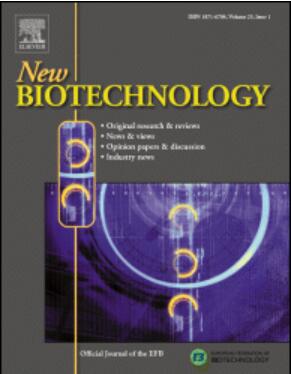量身定制的酶表达修饰希瓦氏菌生物膜和增加电流密度
IF 4.9
2区 生物学
Q1 BIOCHEMICAL RESEARCH METHODS
引用次数: 0
摘要
生物膜的形成是生物电化学系统中电子向阳极转移的最有效途径。然而,在缺氧条件下触发生物膜形成的机制,以及对电流产生积极影响的建筑和组成因素,尚不清楚。最近的研究表明,核黄素在γ-谢氏变形杆菌中具有类似于群体感应分子的功能。核黄素诱导的生物膜形成增强与电流密度增加相关。只有有限数量的候选蛋白被发现由于这种群体感应机制而改变了浓度。本研究表明,udp - n -乙酰氨基葡萄糖C4 epimase WbpP和udp - n -乙酰-d -氨基葡萄糖6-脱氢酶WbpA的催化作用影响生物膜的形成,导致电流密度增加。使用光学相干断层扫描,我们发现每种蛋白质的表达单独导致生物膜结构的特定,可量化的变化,包括生物体积,高度和孔隙度。然而,当这些蛋白单独表达时,电流密度与对照组相比没有显着差异。相比之下,WbpP和WbpA的共同表达导致电流密度增加一倍,与核黄素介导的群体感应所观察到的增加非常相似。我们假设基于核黄素的群体感应可能通过几个中间步骤导致WbpA和WbpP的过量产生,从而更好地附着在石墨阳极上,从而提高电流密度。本文章由计算机程序翻译,如有差异,请以英文原文为准。
Tailored enzyme expression modifies Shewanella oneidensis biofilms and increases current density
Biofilm formation is the most effective pathway for electron transfer to anodes in bioelectrochemical systems. However, the mechanisms triggering biofilm formation under anoxic conditions, as well as the architectural and compositional factors that positively influence current generation, are not well understood. Recent findings have shown that riboflavin can function similarly to a quorum sensing molecule in the γ-proteobacterium Shewanella oneidensis. Enhanced biofilm formation induced by riboflavin correlates with increased current densities. Only a limited number of candidate proteins were found to have altered concentrations due to this quorum sensing mechanism. This study demonstrates that the catalytic functions of the UDP-N-acetylglucosamine C4 epimerase WbpP and UDP-N-acetyl-D-glucosamine 6-dehydrogenase WbpA affect biofilm formation and lead to increased current density. Using optical coherence tomography, we found that the expression of each protein individually causes specific, quantifiable changes in biofilm architecture, including biovolume, height, and porosity. However, the current density did not significantly differ when these proteins were expressed alone compared to the control. In contrast, co-expression of WbpP and WbpA resulted in a doubling of current density, closely resembling the increases observed with riboflavin-mediated quorum sensing. We hypothesize that riboflavin-based quorum sensing may lead, through several intermediary steps, to the overproduction of WbpA and WbpP, resulting in better attachment to graphite anodes and thus higher current densities.
求助全文
通过发布文献求助,成功后即可免费获取论文全文。
去求助
来源期刊

New biotechnology
生物-生化研究方法
CiteScore
11.40
自引率
1.90%
发文量
77
审稿时长
1 months
期刊介绍:
New Biotechnology is the official journal of the European Federation of Biotechnology (EFB) and is published bimonthly. It covers both the science of biotechnology and its surrounding political, business and financial milieu. The journal publishes peer-reviewed basic research papers, authoritative reviews, feature articles and opinions in all areas of biotechnology. It reflects the full diversity of current biotechnology science, particularly those advances in research and practice that open opportunities for exploitation of knowledge, commercially or otherwise, together with news, discussion and comment on broader issues of general interest and concern. The outlook is fully international.
The scope of the journal includes the research, industrial and commercial aspects of biotechnology, in areas such as: Healthcare and Pharmaceuticals; Food and Agriculture; Biofuels; Genetic Engineering and Molecular Biology; Genomics and Synthetic Biology; Nanotechnology; Environment and Biodiversity; Biocatalysis; Bioremediation; Process engineering.
 求助内容:
求助内容: 应助结果提醒方式:
应助结果提醒方式:


